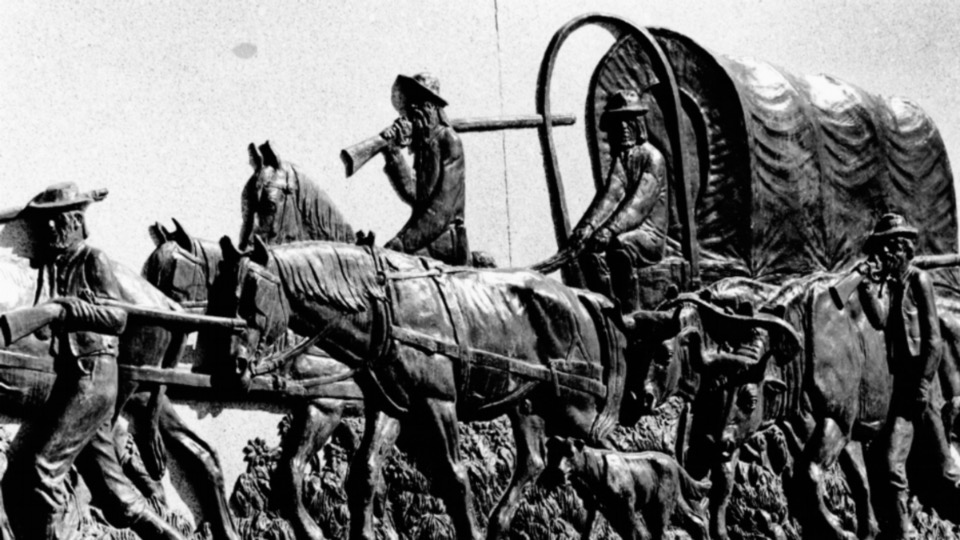
b277d29b747c596576284b07ad40ea67f7daa59c.jpeg
A relief sculpture by Mahonri M. Young shows the first wagon train entering the Salt Lake Valley on July 22, 1847. © 2022 by Intellectual Reserve, Inc. All rights reserved.
This story appears here courtesy of TheChurchNews.com. It is not for use by other media.
The following are day-by-day summaries of what transpired during the final weeks of the Latter-day Saint pioneer vanguard company’s 1847 trek from Winter Quarters, Nebraska, to the Salt Lake Valley.
Sunday, July 4, 1847
Most men in the pioneer company rested this Sabbath morning, having arduously worked since last Wednesday on crossing the Green River in Wyoming. Brigham Young, Heber C. Kimball, Wilford Woodruff and Willard Richards of the Quorum of the Twelve Apostles accompanied the five men they had selected to go back to the Green River ferry with instructions for the Saints they would meet.
As the brethren were crossing the river, they saw 13 horsemen on the other side. Wilford Woodruff recorded: “But to our great joy who should they be but our brethren belonging to the Mormon Battalion who volunteered into the service of the U.S.A. one year ago this month and belonged to Capt. Brown’s detachment who had been at Pueblo (Colorado) through the winter. … When we met it was truly a hearty greeting and shaking of hands.” President Young called for a shout of hosanna for the safe arrival of their brethren from the Army.
The five men were sent on their way east to meet the entire Mormon Battalion sick detachment and the oncoming Latter-day Saint groups. The Mormon Battalion men then stayed with the pioneer company for the rest of the journey. The camp now consisted of 160 souls.
While President Young and his companions were gone to the ferry, a worship service was held under the direction of Bishop Newel K. Whitney.
Monday, July 5
This day the pioneer company traveled 3.5 miles parallel to the Green River and then struck out 16.5 miles across the highland sandy desert. They saw no water or feed during that lengthy stretch.
Orson Pratt recorded, “Several of the camp have for a few days been slightly afflicted with fever, probably occasioned by the suffocating clouds of dust which rise from the sandy road, and envelope the whole camp when in motion, and also by the sudden changes of temperature; for during the day it is exceedingly warm, while the snowy mountains which surround us on all sides render the air cold and uncomfortable during the absence of the sun.”
Tuesday, July 6
The pioneer camp again went forward over the sandy wasteland. Except along the streams when they enjoyed seeing spectacular wildflowers, all they normally saw was sagebrush.
Wilford Woodruff recorded that it was a windy, dusty day. “Man and beast, harnesses and wagons were all covered with dust.”
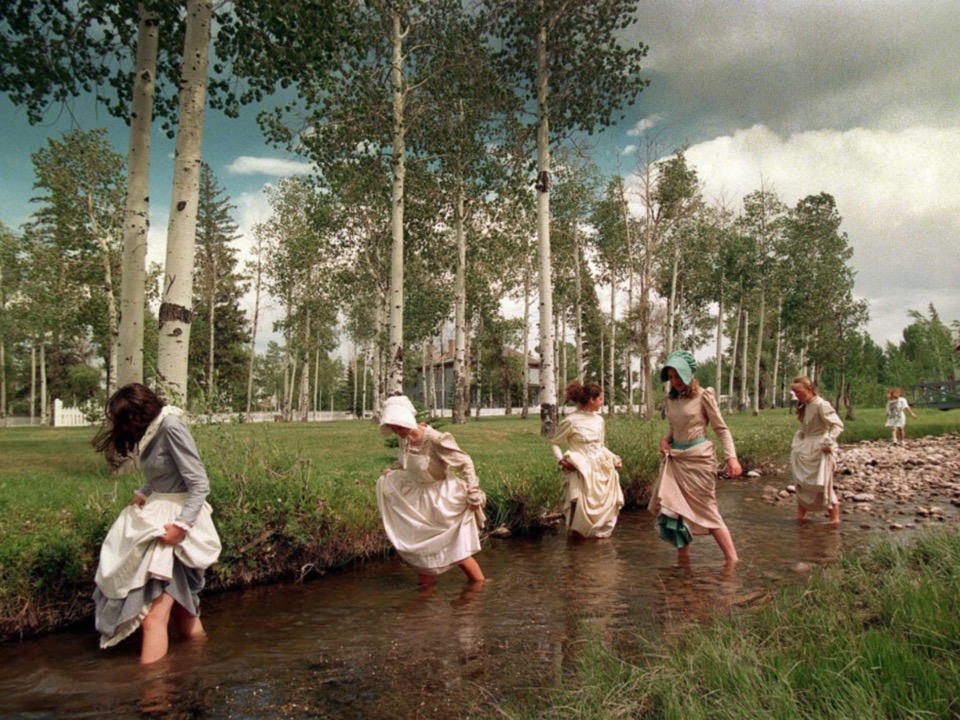
Mormon-Trek-Reenactment_09-1024x702.jpg
Amee Olsen, Darla Jones, Angelene Israelsen, Angie Olsen and Devarie Jones wade in Groshen Creek during the Latter-day Saint pioneer trek reenactment in Fort Bridger, Wyoming, in 1997. The group traveled from Winter Quarters, Nebraska, to Salt Lake City over a three-month period, tracing the pioneer trail. Photo by Jeffrey D. Allred, courtesy of Church News. Copyright 2022 Deseret News Publishing Company.
Wednesday, July 7
The pioneers determined that they would reach Fort Bridger this day, and they succeeded, traveling 17.75 miles.
They knew that they were now only about 100 miles from the Valley of the Great Salt Lake. Orson Pratt calculated they were 6,665 feet above sea level.
Thursday, July 8
The pioneers decided to stay one day near Fort Bridger to do repair work on the wagon wheels and other necessary equipment. Orson Pratt recorded, “Our blacksmiths are busily engaged in setting wagon tires, shoeing horses, etc., and preparing for a rough mountainous road.”
A number of men went fishing for trout in the streams. Most tried grasshoppers or meat as bait. But Wilford Woodruff wanted to try his new artificial fly that he had obtained a year earlier in Liverpool, England. “And it being the first time that I ever tried the artificial fly in America, or ever saw it tried, I watched it as it floated upon the water with as much intense interest as (Benjamin) Franklin did his kite when he tried to draw lightning from the skies.” Immediately Wilford had success and continued until he had caught 12 in all. The other fishermen had little luck, which Elder Woodruff said “was proof positive to me that the artificial fly is far the best thing now known to fish trout with.”
Friday, July 9
The pioneers departed Fort Bridger early in the morning and almost immediately took off in a different direction from the other travelers headed west.
The day’s journey of 13 miles was difficult. They had to traverse some high ridges. On one of them the brethren had to lock their wagon wheels, and the wagons had to be constrained by ropes on one descent. William Clayton said the descent was the “most difficult we have ever met with, being long and almost perpendicular.” At the end of the day, however, the cattle were rewarded with tall bunch grass.
Wilford Woodruff contracted the mountain fever and spent a most uncomfortable day in his wagon. He said, “I took to my bed at 10 o’clock with distressing pain in my head, back, joints, bones, marrow, etc. all through the system attended with cold chills and hot flashes through the body.”
Saturday, July 10
For the first time on the journey, the pioneers were forced to cope with real mountainous country. They went up and down three steep mountain ridges over 18 miles. At one point the men had to break out shovels to dig a wider path in the mountain gap. At their new encampment, they found the most delicious spring water of their journey. This camp was near the present Wyoming-Utah border.
In the evening Miles Goodyear, the only white settler in 1847 in present-day Utah, who lived in what is now Ogden, visited the pioneers’ camp. Goodyear gave a favorable report of the Great Basin valleys.
Sunday, July 11
A few pioneers went exploring on this Sabbath day of rest. Brigham Young, Heber C. Kimball and William Clayton went up the mountain to the east of camp and had a pleasing view of the surrounding 10-mile-wide valley.
During this day of contemplation, a number of pioneers discussed how difficult it would be to colonize the mountains; others were very confident and excited about the prospect.
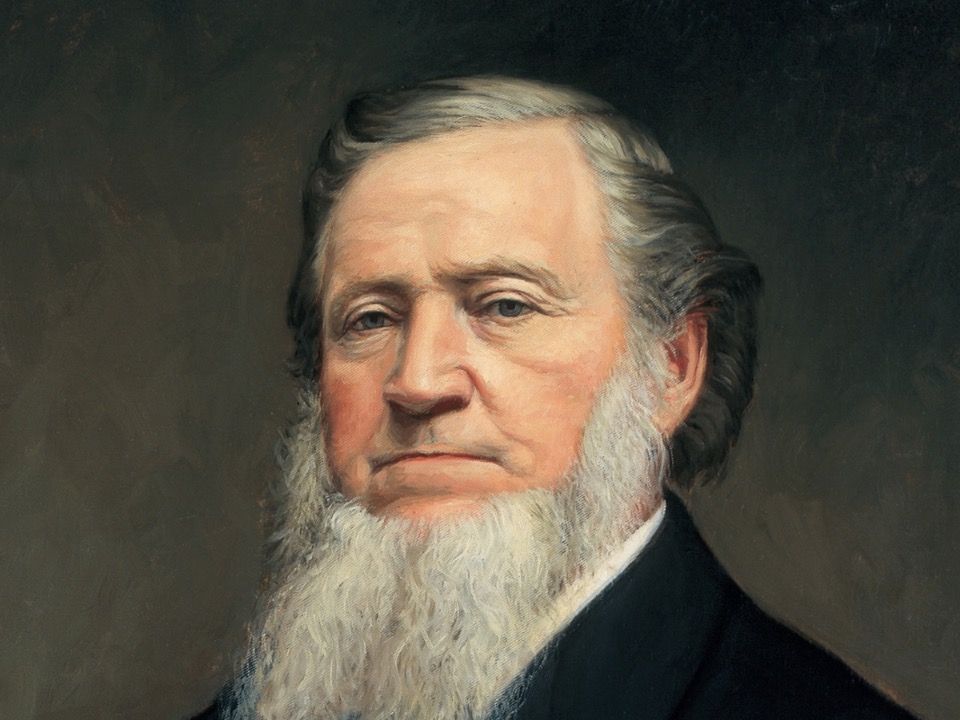
Monday, July 12
The pioneers embarked again in mostly uncharted territory on their mountainous course. “We drove without any road over hills and dales. Had to take our own road as we went along,” wrote Wilford Woodruff. Elder Woodruff, buoyed by his success at fly fishing earlier, took opportunity to fish at every stream.
Before stopping at noon, President Brigham Young contracted the mountain fever that had afflicted so many others earlier. Several wagons waited behind in the afternoon so that he could rest and at the same time be cared for and protected. This marked the beginning of three groups in the pioneer company: the forward group under the direction of the pathfinder, scientist and Apostle Orson Pratt; the main body; and the rear guard with Brigham Young and some of the other sick.
The advance company made 16.5 miles during the day.
Tuesday, July 13
This was a day of subdued contemplation and decision-making. During the night, President Brigham Young was so sick that he was insensible. Another pioneer leader, Albert Rockwood, was likewise afflicted. Throughout the Camp of Israel, prayers ascended to heaven for their recovery and that of the other sick.
Shortly before noon, Elder Heber C. Kimball, second in command, caught up to the Cache Cave camp and called a meeting of the Apostles and other council members. They concluded to send 23 wagons and 43 men ahead under Orson Pratt to find a road over the mountains.
Wednesday, July 14
Each of the three separate pioneer companies spent the day differently. Orson Pratt’s advance company plodded its way down the narrow Echo Canyon 13 1/4 miles to the junction with the Weber River. They often had to use their shovels to fill in ravines or dig out tree stumps to make the rugged road more passable.
The main company tarried at the Cache Cave camp. More men took sick with the mountain fever.
Seven miles east of the main camp were the eight wagons with Brigham Young. President Young felt better this day, but Albert Rockwood was worse, and according to Wilford Woodruff, was “much the sickest man that had been in the camp.” Elder Woodruff decided that he would obtain his carriage in the morning, bring it back to the camp, place beds in it, and use it to transport President Young and other ill men over the road.
Thursday, July 15
Orson Pratt’s advance company journeyed down the Weber River 6 miles.
Early in the morning, Wilford Woodruff took his carriage back to Brigham Young and Albert Rockwood. “I found them much better in health and they thought they could ride as my carriage was the easiest vehicle in camp.”
This was the last full day for the Mormon Battalion in California in the service of the United States. Company B’s soldiers arrived in Los Angeles to be discharged the following day.
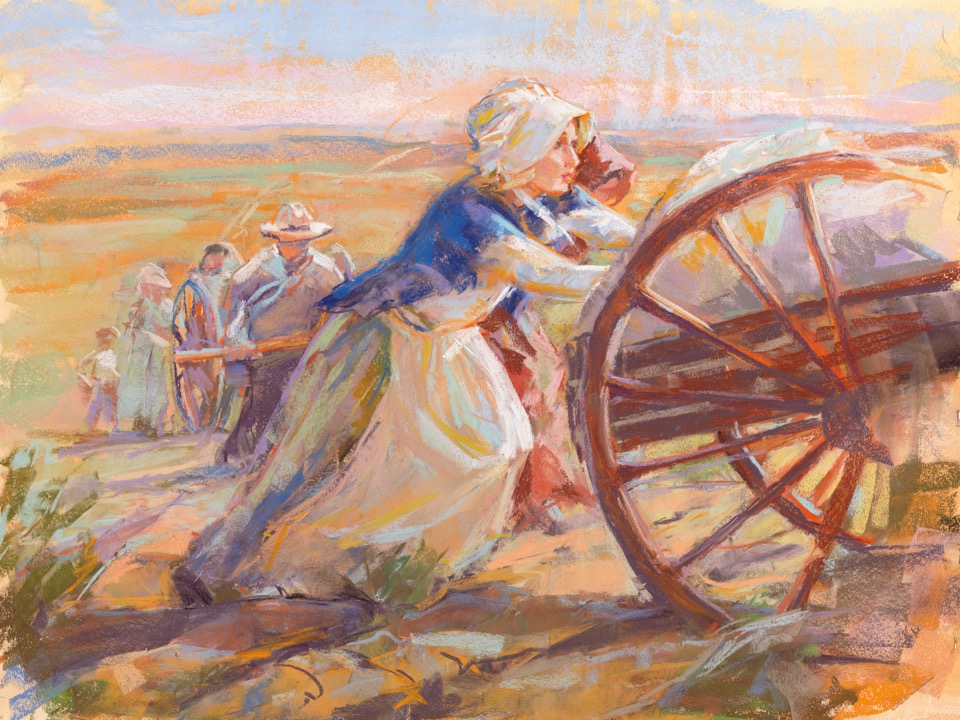
4435dc0b8a19599b60a1d8660dbc961f8d7ca4b4.jpeg
Painting by Julie Rogers of a woman pushing a handcart. © 2022 by Intellectual Reserve, Inc. All rights reserved.
Friday, July 16
The advance company continued laying a road up and down the mountain passes for about 6 miles. A small company of a dozen men went ahead and exercised considerable labor with spades and axes to make the trail passable for the wagons.
The main camp pushed on down Echo Canyon 16.75 miles and camped 1 mile shy of the Weber River. The pioneers witnessed a variety of grains, vines, berries and flowers. They were convinced that the weather couldn’t be too bad in the mountains and that frosts were not as likely to kill off the crops as they had feared. The echoes in the canyon were curious to both man and beast.
At 3 p.m. at Fort Moore in Los Angeles, 317 men of the Mormon Battalion assembled by company. They were formally discharged. Only 79 battalion members had reenlisted. The others left with their animals, arms and ammunition and went to a spot on the San Pedro River to prepare for their return to the Saints.
Saturday, July 17
Brigham Young did not feel up to traveling this morning. Thus, the main company went to work repairing Solomon Chamberlain’s wagon axle that had snapped the day before. Wilford Woodruff reported, “The Twelve with some others went out together and prayed in due form for Br. Young and all the sick.”
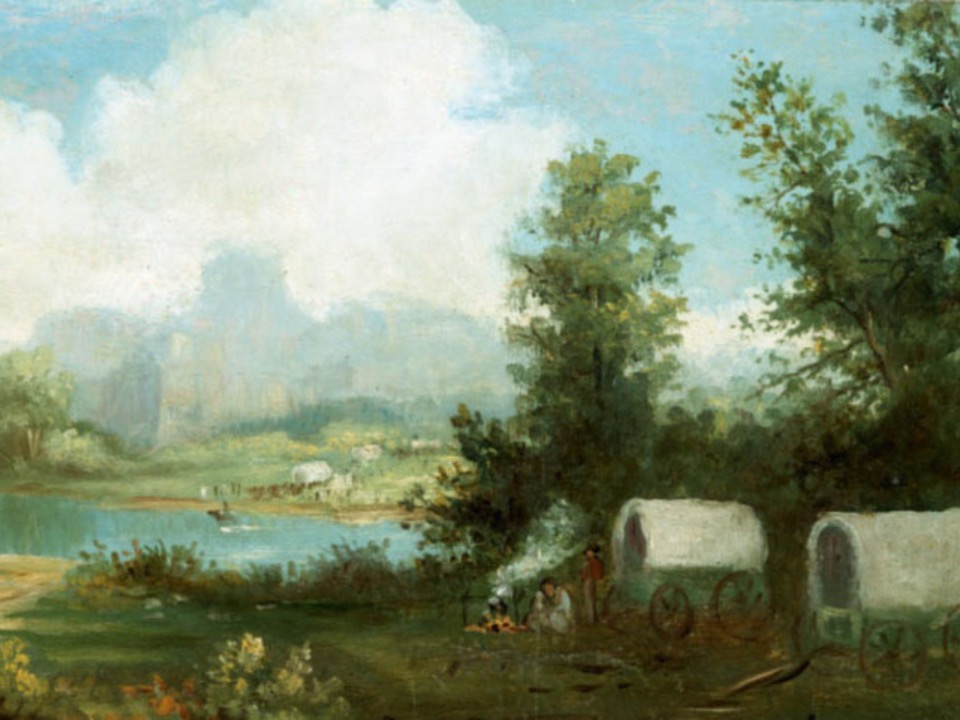
254e22575484f810bfd1420acbe4334aff7b56c6.jpeg
A painting of covered wagons stopping at Green River, Wyoming, by George M. Ottinger. 2022 by Intellectual Reserve, Inc. All rights reserved.
Sunday, July 18
On this Sabbath, the main pioneer company, camped near the Weber River at the foot of Echo Canyon, spent the day in fasting and prayer. Elder Heber C. Kimball reported that President Brigham Young was deathly ill and proposed that all the men humble themselves before the Lord so they could obtain the Lord’s power to turn away sickness and disease from the camp.
Elder Kimball proposed that eight or 10 wagons remain behind with President Young until he had regained his health sufficient to travel. The others could proceed toward the Salt Lake Valley in order to put some potato seeds in the ground. “We have little time to spare,” he emphasized.
In the evening Elders Kimball, Wilford Woodruff and Ezra T. Benson of the Quorum of the Twelve Apostles went onto a high hill and held special prayer.
Monday, July 19
According to Wilford Woodruff, this day’s route was “the worst road we have had on the journey.” Time and again they had to go up and down steep ridges. They were careful to get on to what they called “Pratt’s Pass,” the route scouted by Orson Pratt a few day’s earlier and the same route taken a year earlier by the Reed-Donner party.
The advance company continued to widen and strengthen the Donner Trail as they plowed on for 6.5 miles. Meanwhile Orson Pratt and John Brown explored ahead.
Tuesday, July 20
The main camp was delayed in its march until 11 a.m. due to blacksmithing repairs on broken wheels. William Clayton recorded, “Although there has been a road cut through, it is yet scarcely possible to travel without tearing the wagon covers.”
Brigham Young’s rear company of about eight wagons started early in order to travel in the cool of the day.
Wednesday, July 21
This was an exciting day in the pioneer journey. Elder Willard Richards sent a letter via Erastus Snow to Orson Pratt giving instructions about entering the Salt Lake Valley and planting seeds. Brother Snow caught up with Elder Pratt in the morning and both of them went ahead of the vanguard company to explore. At the top, the broad expanse of the beautiful valley lay before them. “We could not refrain from a shout of joy which almost involuntarily escaped from our lips the moment this grand and lovely scenery was within our view,” recorded Elder Pratt that night.
Members of the main company started their trek at 6:30 a.m. to try to get as far as they could this day. Most difficult was ascending and descending the steep mountain ridges.
Brigham Young’s rear company stayed at East Canyon Creek because of sickness among them.
Thursday, July 22
Most of the pioneers reached their destination of the Salt Lake Valley this day. Only those few in Brigham Young’s rear company for the sick were still behind. Thomas Bullock, expressing the feelings of the group, wrote, “A very extensive valley burst upon our view, dotted in three or four places with some timber.” He could not help shouting, “Hurrah, hurrah, hurrah, here’s my home at last!”
Elder Orson Pratt went back to the main encampment and met in council with his fellow Apostles Willard Richards and George A. Smith. They concluded that Elder Pratt and Elder Smith would immediately lead a group of eight men into the valley to locate appropriate places for planting. All others would be left in the canyon to clear a road through the thick brush.
President Young’s company resumed its journey at 7:30 a.m. and traveled 8 miles over the rough road up East Canyon Creek to the bottom of Big Mountain.
Friday, July 23
The pioneers broke camp at 7 a.m. and made their way to the south branch of a stream (City Creek) flowing out of the northern mountains surrounding the Salt Lake Valley. This flat land blessed with outstanding soil had been located the day earlier by Orson Pratt’s company. At 9:30 the Apostles called a prayer meeting at the spot later occupied by the Salt Lake City and County Building.
Elder Pratt recorded, “After imploring His blessings upon our labors, we appointed various committees to attend to different branches of business, preparatory to putting in crops, and in about two hours after our arrival we began to plow, and the same afternoon built a dam to irrigate the soil, which at the spot where we were plowing was exceedingly dry.”
Brigham Young’s small group of wagons continued to thread its way through the mountains, first the 5 miles up Big Mountain, then the 6 miles down, and then 4 more miles up Little Mountain and down to Last Creek (Emigration Creek). While on Big Mountain, President Young asked Wilford Woodruff to stop his carriage for a few moments so that he could look at the Salt Lake Valley.
“The spirit of light rested upon me and hovered over the valley,” the Church leader noted. “I felt that there the Saints would find protection and safety.”
Saturday, July 24
Around noon, the few wagons that included President Brigham Young, Elder Heber C. Kimball and the sick members of the pioneer company emerged from Emigration Canyon. President Young, though still weak from illness, stood up in Elder Woodruff’s wagon. He noticed a conical peak (Ensign Peak) in the distance at the north end of the valley. He recognized it as the same mountain he had seen earlier in vision. He said: “It is enough. This is the right place, drive on.”
Sunday, July 25
This was the first Lord’s Day in the Latter-day Saints’ refuge in the West. Two general services were held — one at 10 a.m. and the other at 2 p.m. Each of the Apostles present had a chance to speak as well as a few others.
Brigham Young counseled that anybody who chose to work on the Sabbath would lose five times as much as he would gain by the work. He established the first land policy for the new community. No one would buy or sell land; rather each man would have as much land measured to him as he could till, but that he was fully expected to be industrious and take care of it.
Monday, July 26
This was a day of hard work for most of the pioneers as they plowed and planted their new agricultural plots. Others went by assignment to make a road to gather timber in City Creek Canyon to the north.
The Apostles and a few others in their general council took off in a private exploring expedition. The small company proceeded up the mountains to a place they named Ensign Peak.
The brethren determined the general location of the new temple in the middle of the city that lay before them.
Epilogue
During the first week in the valley, the pioneers plowed and sowed 53 acres with potatoes, peas, beans, corn, oats and buckwheat. Explorers studied the entire valley of the Great Salt Lake and some of the adjoining canyons. The first roads were made to timberlands. The first saw pit was constructed.
On July 29 an additional 200 Latter-day Saints arrived comprised of the Mormon Battalion sick detachment and some Mississippi Saints who had also wintered in Pueblo. These additions raised the total number in the valley to about 350.
Three weeks after the arrival in the valley, the first contingent of 71 men and 33 wagons started its journey back to Winter Quarters. On August 26, Brigham Young and the Apostles led another group of 108 men back toward Winter Quarters. The 180 people left in the valley tended the crops and continued building a fort at the present location of Pioneer Park in Salt Lake City. Their number was increased by 1,500 from the so-called “Big Company,” led by Elders Parley P. Pratt and John Taylor. They arrived in late September and early October.
Copyright 2022 Deseret News Publishing Company.
In 1997, Bruce A. Van Orden was a member of the Church Pioneer Sesquicentennial Committee and a BYU associate professor of Church history and doctrine. These summaries were published in the Church News 25 years ago, during the sesquicentennial of the pioneer trek. Some spelling and punctuation modernized.